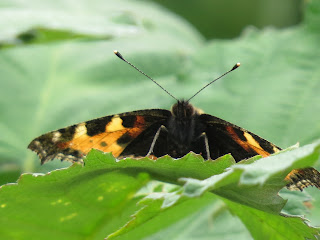After that fantastic day out on the boat to see those seals yesterday, there is nothing better than to recapture the encounter with some drawings. Seals appear to us as playful marine creatures, but the truth was they were very lazy during our boat ride, lazily lounging on the sand. You could easily spend hours drawing them and they would happily oblige to pose for you.
 |
| Stage One |
I will show you how to draw a lounging common seal first. The basic shape for a seal is a circle (or oval if you are drawing a grey seal) for the head, a large, elongated oval for the body and a smaller oval for the hind flippers. If you want to draw a seal with it's hind flippers raised into the classic seal pose, draw a banana-shape for the body and put the smaller oval on the end, pointing up.
 |
| Stage Two |
Using the shapes you have just drawn, connect them together to create the main outline of your seal. Add in the flippers. Draw a line down the centre of the head and cross it with three lines which helps measure the positions of the facial features. Then draw the teddy bear-like nose and under that, draw a curved line for the mouth and then create a circle for the muzzle around the two features. Using the line that is remaining, draw in the eyes.
 |
| Stage Three |
Redraw in pen and rub out the pencil lines. Using the pen, lightly shade the seal in. Add the spots in over the shaded areas. Think about which sections of the seal's body is densely packed with spots and which are lightly spotty. You might need to combine a bit of slightly heavier shading on top of the densely packed, spotty regions.
 |
| Stage Four |
Colour in your seal. A common seal sandy brown to lightly grey. I have mixed in a light brown with light grey over the top of it. I have also used a bit of yellow to help highlight some lighter areas show up better.
 |
| Stage One |
Seals are more playful and curious when in the water. A classic bit of seal behaviour is to poke their heads up above the waves. My next drawing will be of a grey seal doing just that. I start by drawing an oval for the head and two lines on either side of it with a scribble connecting them to represent the sea.
 |
| Stage Two |
The snout of a grey seal is longer and similar to that of a dog. It can be tricky to draw. What I do is to create rough shapes like a circle for the muzzle and a sort of pear-shape for the length of the snout. Then it is a matter of adding a mouth, two nostrels, the whisker pores and the eyes, as well as the rest of the outline for the seal's head and body.
 |
| Stage Three |
Once you have drawn over the outline in pen, begin shading the seal in as well as the water around it. Each seal is different in appearance, so shade in however you like. The head of my seal is black with a lighter grey body covered in spots. I suggest starting around the muzzle first and working around the eyes as these areas can easily be muddled with by a stray scribbled line and need a bit of concentration while working on them. When you have finished, draw lines for whiskers around the muzzle.
 |
| Stage Four |
Finally, colour your seal in. Grey seals come in a variaty of shades of greys, browns and blacks.
Seals are fun to draw and if you find one that is willing to pose for you, you should take up on it's offer and draw away. It is a great way to spend some time by the seaside, as long as the wind does not blow your pages from you.
































































